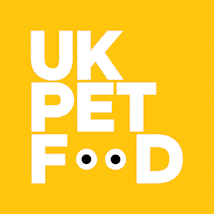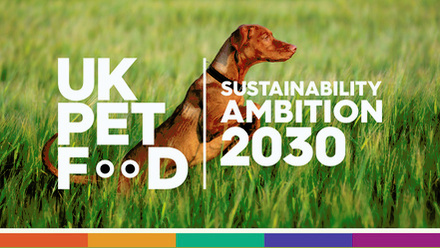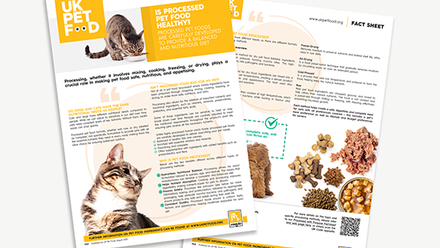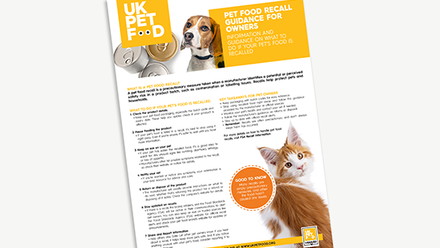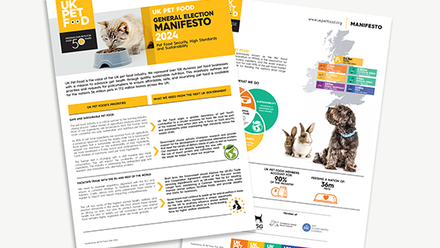Pet food labels have nothing to hide
Labelling Options – Q&As
To make sure pet owners are fully informed, the Pet Food Manufacturers’ Association (PFMA) has a detailed Q&A document explaining why some products use generic labelling terms and how this can benefit owners.
PFMA also highlights that its members use one of two labelling options. Many pet food products do provide a full ingredients list, so ultimately, pet owners have the choice of what best suits them and their pets.
Strict Legislation
There is strict legislation covering what ingredients can be used in pet foods to ensure they are safe and nutritious. With regards to the animal-based ingredients in pet food, these must come from animals that have been inspected under veterinary supervision and are considered fit for human consumption.
Complete Food
The most important thing owners need to look for on the pet food label is the term ‘complete’ (another legal term), as this means the pet food must contain (by law) all the nutrients a pet needs for healthy bodily function.
To ensure a ‘complete’ pet food, PFMA members formulate their diets in line with the latest science on small animal nutrition, such as the FEDIAF Nutritional Guidelines for Cats and Dogs. These guidelines detail the nutritional needs of cats and dogs at the varying life-stages and they are reviewed by independent veterinary nutritionists across Europe.
Additional Reference:
PFMA has a series of education resources on these topics to help owners on the important decision of what to feed their pet.
Veterinary Nutritionist, Dr Marge Chandler, advises the top 3 things owners need to think about when selecting a pet food:
https://www.pfma.org.uk/healthy-pet-food-checklist
Additional reference material includes:
PFMA ‘Understanding Pet Food Labels’ factsheet:
Understanding Pet Food Labelling | UK Pet Food
PFMA’s short video explaining what ‘Meat and Animal Derivatives’ are:
Ingredients insight: animal proteins in pet food | UK Pet Food
PFMA’s 2-minute film ‘How pet food is made for cats and dogs’:
Q&A
Why are pet food labels so difficult to decipher? We recognise that pet food labelling isn’t always consumer friendly and that sometimes the terminology can be confusing. Pet food labelling falls under EU legislation for farm animal feed, meaning that the way information is listed on-pack is not always understandable for pet owners.
Despite the regulatory constraints, PFMA and its members are committed to providing pet owners with a better understanding of what is in their pet’s food. This is why many pet food manufacturers provide full product information on company websites and have dedicated customer care lines to provide further support.
Why do some pet foods list ingredients and others are vague – using terms such as ‘cereals’? Current legislation means manufacturers can label ingredients by category or by individual ingredients. Listing ingredients by category means manufacturers can select ingredients based on supply without having the high cost of changing labels constantly and means they can deliver an economical product of high quality. There is a wide range of pet foods in both labelling formats so pet owners have the choice of what suits their pets needs and preferences.
When a label says meat and animal derivatives (4% chicken) on the pet food label does this really mean that there is only 4% meat in the products? The pet food industry works hard to help consumers understand the legislation particularly surrounding labelling. For example, when a pet food label states 4% of a certain meat ingredient, this does not mean that the product contains only 4% meat. The 4% declaration is a legal labelling requirement which represents the minimum percentage content of the named ingredient guaranteed to be present by the manufacturer. Each recipe includes a blend of different ingredients which are all combined into a food which will meet, in part or entirely, the daily nutritional requirements of the pet.
What ingredients are typically used? There is strict legislation covering what ingredients can be used in pet foods to ensure they are safe and nutritious. With regards to the animal-based ingredients in pet food, these must come from animals that have been inspected under veterinary supervision and are considered fit for human consumption. Cuts that might not sound appealing to the UK consumer but which might be regularly on the menu in other cuisines or that have been eaten in the UK in the past (e.g. pigs trotters, or fried pig ears, udders) are used. The main concern for the pet food manufacturer is to source nutritionally valuable raw materials. Some of the less favoured cuts could be a perfect source of protein, essential amino acids or other valuable substances.
For more information on ingredients, please visit:Ingredients insight: animal proteins in pet food | UK Pet Food
What causes pet obesity? Pet obesity is as serious an issue for pets as it is for people. The cause is straightforward too many calories in and not enough burned off. To help owners keep their pets at a healthy weight, PFMA has developed a simple 7 step guide
Considering a change of diet? Any sudden change in diet might cause a stomach upset in your pet. If you’re switching diets, this should be done gradually over a period of 5-7 days. Start by introducing a little of the new diet to your pet’s regular food gradually increasing this over a few days whilst decreasing the old food. Follow the feeding guidelines as these can vary between the different products and brands.
